Quick Look at Core M 5Y70 and Llama Mountain
by Joshua Ho on September 10, 2014 2:36 PM EST
Today, Intel showed off a reference design codenamed Llama Mountain, which is an incredibly thin tablet running Intel's Core M 5Y70. While we've covered Core M previously it's worth going over again for those unfamiliar with this chip. For reference, it's the first shipping implementation of Broadwell and designed to target a 4.5W TDP. This means that it's fully possible to integrate a full Windows PC into a thin, fanless formfactor. We've already seen the announcement of the ThinkPad Helix 2 with Core M, so it's clear that this new chip can support such formfactors.
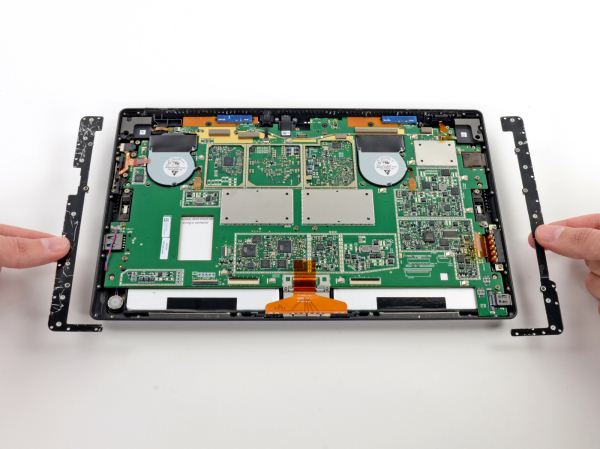
One of the biggest surprises for me was how much smaller the PCB was in Llama Mountain. For reference, the photo above is from our Surface Pro teardown. The PCB takes up almost the entirety of the tablet, and there's a great deal of extra thickness from the fans in the device. I managed to get a photo of the entire Llama Mountain board below. The second green PCB contains the storage (a SanDisk iSSD solution) and a WiFi chip (Intel 7260AC).
The resulting tablet is incredibly light at 684 grams. For reference, the iPad Air is 469 grams. Of course, the real question is whether the extra ~200 grams is worth it. To get an idea of whether or not it is, Intel showed the performance of Llama Mountain in Sunspider 1.0.2 and 3DMark Ice Storm Unlimited. I've put the results into the graphs below.
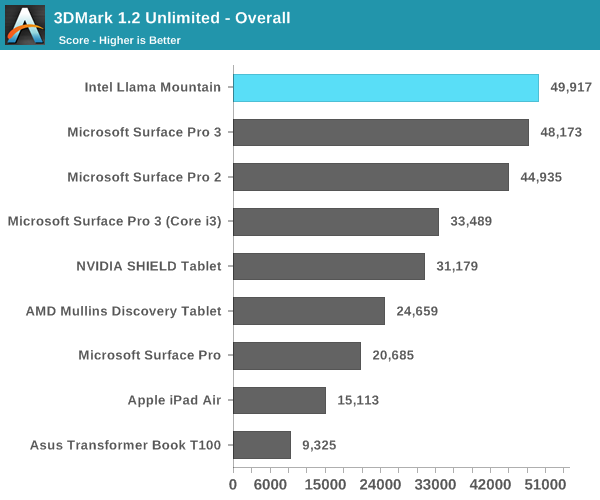
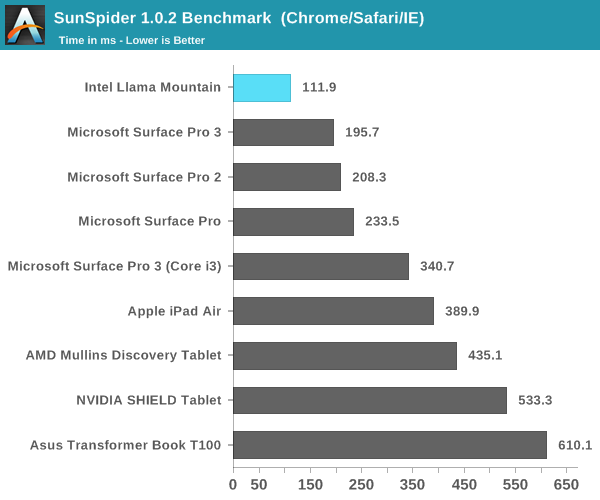
Needless to say, the Core M 5Y70 is the fastest tablet that we have test results for. The Surface Pro line has 15W TDP parts, while Core M operates in a 4.5W TDP. However, for this reference design Intel is leveraging the large amount of surface area to drive a 6W TDP. Despite this, it seems that it manages to equal or better the Surface Pro line in performance. Intel also emphasized that only an aluminum back cover would be needed to dissipate the heat to keep costs down. In fact, there were versions of Llama Mountain with copper and gold-plated back covers, but had no noticeable effect in performance. I'm definitely looking forward to future tablets and 2-in-1 devices launching with this chip, as this could enable laptop levels of performance in a tablet formfactor without the compromise we see now.


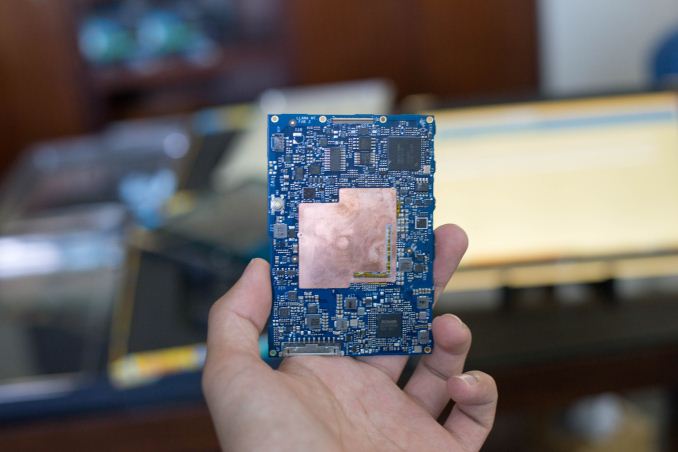
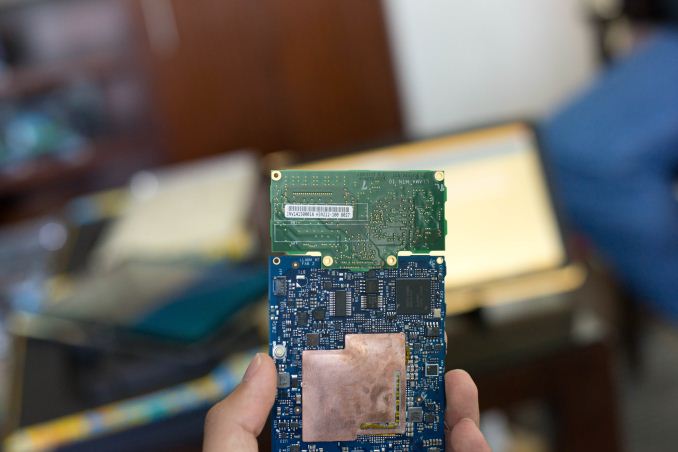









81 Comments
View All Comments
Homeles - Wednesday, September 10, 2014 - link
"One of the biggest surprises for me was how much smaller the PCB was in Llama Mountain. For reference, the photo above is from our Surface Pro teardown. The PCB takes up almost the entirety of the tablet, and there's a great deal of extra thickness from the fans in the device."To be fair, that Surface Pro board isn't very dense at all. Look at Apple's Haswell-equipped logic boards, and you'll get a really good idea of what can be done with Haswell. Still, that Broadwell board is much smaller, and it'll be amazing to see how much more they can condense things over the next few generations.
jhoff80 - Thursday, September 11, 2014 - link
Yeah, a better comparison would've probably been the Pro 3 board, which is small in itself, and Broadwell is still much smaller. Pro 3 (from iFixit):https://d3nevzfk7ii3be.cloudfront.net/igi/nEKPhsVy...
Infy2 - Thursday, September 11, 2014 - link
That sun spider test for Core M has been run under IE and Surface Pros on Chrome obviously. Running that test on 5Y70 on Chrome would give score around 172. Optimally one should not compare web benchmarks between different browsers. IE is heavily optimized for sun spider while in other tests looses to Chrome almost twofold.aryonoco - Thursday, September 11, 2014 - link
I wonder what's the chances of someone picking Core M up and using it in a high-end Chromebook.Probably not much, manufacturers are scared of high-priced Chromebooks after the Pixel, but I think the market has markedly changed, and if someone picked this up, put it in an attractive-but-not-over-the-top body and matched it with a nice keyboard and trackpad and a 1080p IPS display and sold it for $699, it would do very well. If an OEM excluded fancy things like WiGiG or Wireless Charging or touchscreen panels or any of that, and sticks to the basics, I think it would be possible to hit that price and still have decent margins.
Speedfriend - Thursday, September 11, 2014 - link
Where are all those people that were claiming the A8 was going to be as fast as this? This looks frankly fantastic and I find it hard to believe that an iPad Pro is on the cards against a tablet like this. Watch Apple surprise us and release a touch enableled MacOS tablet running this chip!willis936 - Thursday, September 11, 2014 - link
That really would be a surprise because it would make half of their current product line obsolete.kron123456789 - Friday, September 12, 2014 - link
this chip itself costs more than half iPad.Shadowmaster625 - Thursday, September 11, 2014 - link
With such a simple and modest pcb we should be looking at a complete tablet BOM of around $100 for a 7" with 32GB of NAND. Plus the cost of the cpu of course. Now the question is, how is intel going to charge $200 for the cpu. In the past they have always offered "good enough" celerons and pentiums for a <$100 tray price. (Such as the 3560Y) So when the first broadwell sub 5 watt pentium is released, they might actually start gaining market share.iwod - Saturday, September 13, 2014 - link
4.5W TDP, Imagine additional work going into this for 10nm, it may well fit into a phone.simard57 - Monday, September 15, 2014 - link
in comparing the PCB from Pro 3 to the one in the new tablet, does that mean I can expect the extra space to be replaced by a larger battery so we get a double win - less power hungry AND larger battery for a much increased tablet battery life without an increase in weight!Sweet!